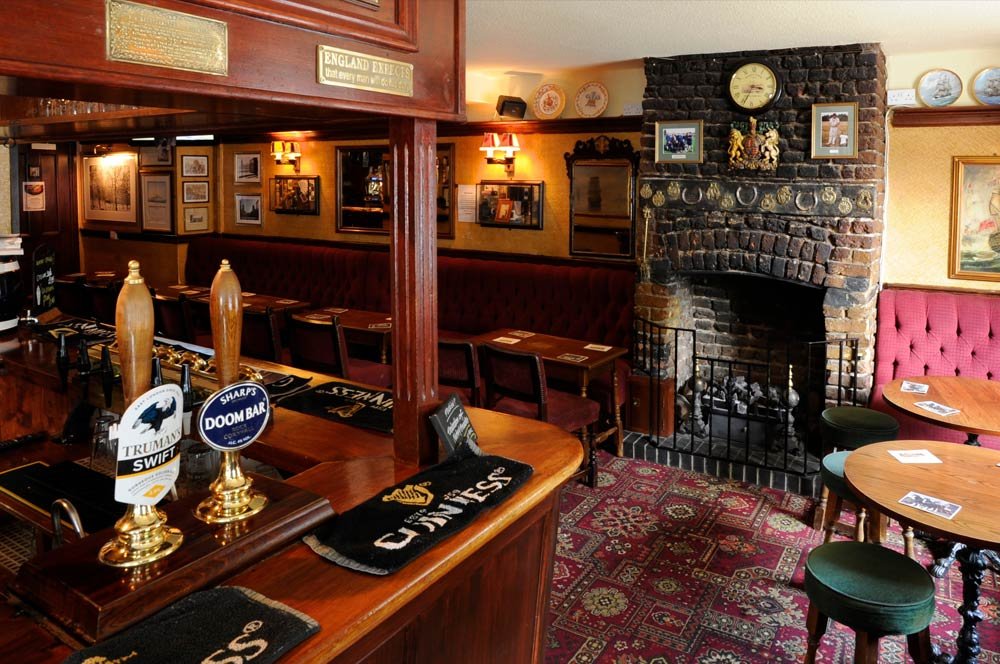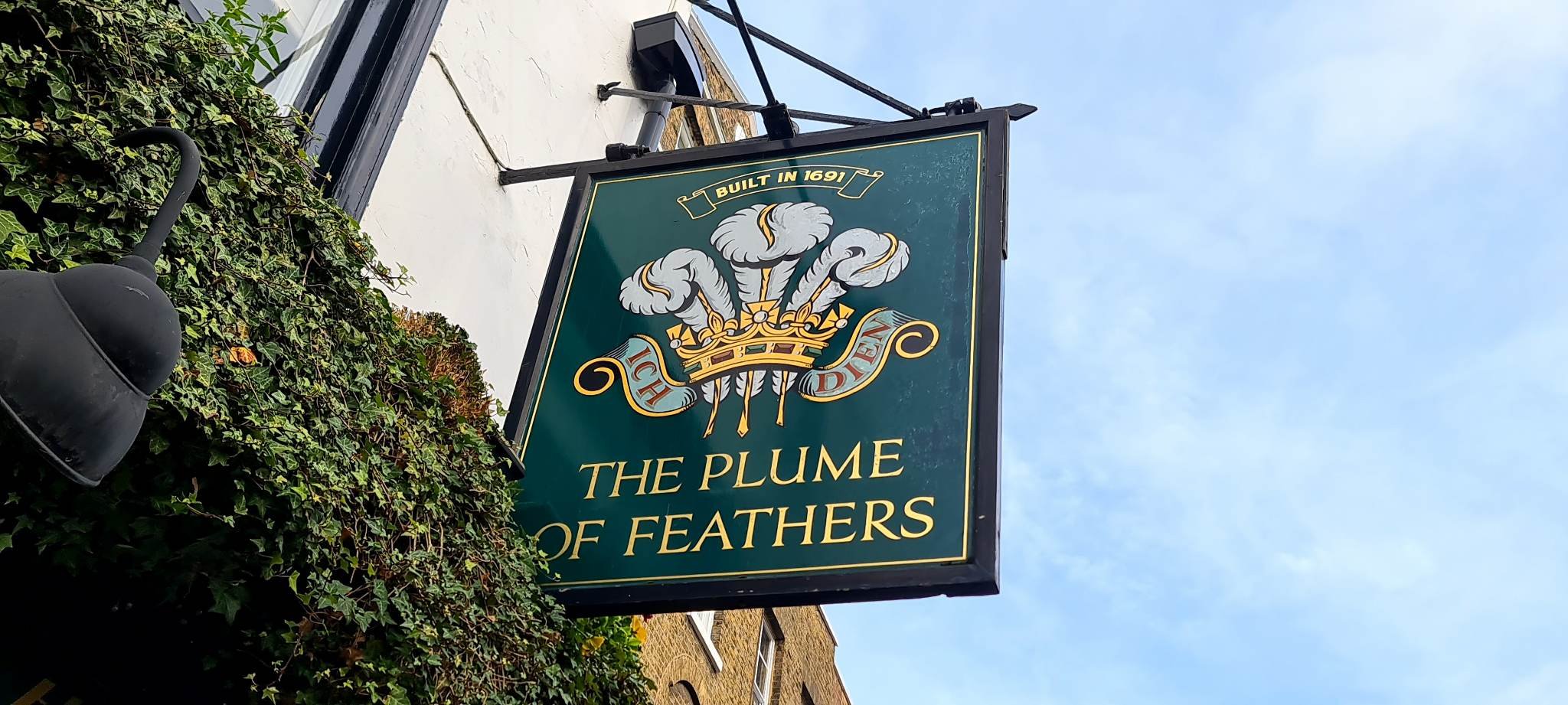
HISTORY OF THE PLUME
“A traditional boozer that is nicely tucked away by the park”
Who would have thought that just a few generations ago the landlord of the Plume of Feathers had a servant? But there she is, good old Elsie Bunyan, aged 29, in the 1911 Census. Name: Elsie May Bunyan. Sex: F. Relationship to head: Servant. Occupation: Domestic.
But times change and with it does Greenwich’s oldest pub. Today most people would say the Plume of Feather ‘is a traditional boozer that is nicely tucked away by the park’. That’s its charm and that’s the way us locals like it. And it’s all thanks to Lord Romney.
“For a few years the pub enjoyed being right there on the ‘main’ road”
The pub was built in 1691, and was ideally situated on the busy Dover Road as travellers left Greenwich. Coaches and carts would pass through the gatehouse of the Queen’s House (possibly paying a toll there) and on their left would be the perfect place to stop off before they headed towards Kent. It’s likely that as well as being an inn, livestock, such as cows and sheep, were also kept here. Samuel Travers map of 1695 describes the area as simply, ‘Freehold Lands in the Lordship of East Greenwich and some Lands belonging to Lady Biddulph and Others within the manor of West Comb.’
But as traffic increased Lord Romney, the Park Ranger at the time, decided the original road was not big enough, so in 1699 he built a new one (with some other men obviously) about 100 metres to the north. It’s the Romney Road you still use today as you head towards Woolwich and beyond. But for a few years the pub enjoyed being right there on the ‘main’ road.
“Greenwich… had… been making every effort to transform (itself) from impoverished fishing village into neat little suburbs”
William III and Mary II were on throne when the pub first opened for business. On 12 July William III’s troops defeated Irish and French troops who were supporting the Catholic James II in the Battle of Aughrim as part of the War of English Succession. At that time there was no National Debt (it only came into effect in 1694) or even a Bank of England (same year). The population of London as a whole was only 550-600,000. Greenwich Observatory was there (1695) – but what is now the Old Royal Naval College was not because although Mary II commissioned Christopher Wren to build the then Royal Hospital for Seamen in 1692/3, it was only started in 1696.
Clive Asslet, in his book Greenwich Millennium, describes the scene at the time the pub was built: “Greenwich… had… been making every effort to transform (itself) from impoverished fishing village into neat little suburbs. At the beginning of the eighteenth century the Seamen’s Hospital was edged by a surf of higgledy-piggledy timber-fronted houses tumbling into mean streets and around odd little inlets and courts.”
“Every time you use an old-style two pence piece the Plume will be staring you in the face”
Evidence of the pub appears in the Greenwich Parish rate books in 1717 when John Isaacs (possibly the landlord) was paying rates of 10 shillings and 8d. Licensing records reveal that the pub was at that time called the Prince of Wales. Widow Jane Whitall took over the pub a few years later and by 1726 had changed the name of the pub to The Plume of Feathers.
The Plume of Feathers is, of course, the heraldic badge of the Prince of Wales. Although the use of three ostrich feathers can be traced back to Edward, the Black Prince, who probably adopted it after it appeared at the wedding of his parents, Edward III and Philippa of Hainault, by the time of the Widow Whitall it was firmly in the preserve of the Prince of Wales. Today the Plume insignia makes regular appearances in our lives as it is used by numerous military regiments, the Welsh rugby team and the Surrey County Cricket Club to name a few. And every time you use an old-style two pence piece the Plume will be staring you in the face.
“The rateable value for the pub at the time being £12”
The Whitall (or Wheatall) family – Jane, Stephen and Charles – were landlords until 1770 when the licence was transferred to John Bendell, with the rateable value for the pub at the time being £12. Just before this Charles Whitall had bought a small cottage, part of the terrace to the west side of the pub, and it’s likely the two properties were knocked into one. When the cottages on the site of 21 Park Vista were demolished in 1952 it was found that the beams ran through to the pub (the previous end cottage that had been bought in 1770).
It’s possible, like many pubs of today, that the Plume changed its name from time to time. For instance, a sketch map of 1792 refers to it simply as the Feathers Inn, with land to the east of it marked as ‘Tribunes reserved for the use of James Taylor Esq and servants of Park Place’. Over the years the pub has been owned by various individuals, the Beehive Brewery, the Hoare Brewery, the Watney Brewery, Truman’s Brewery, Courage Supply Line, and Scottish & Newcastle.
“Susan Rose and son James have been independent landlords since 1999”
In 1884 Greenwich’s meridian was adopted by the world as the prime meridian of the world (except the French, who continued to use the Paris one until 1911) and in that moment the Plume of Feathers became the first pub in the Eastern hemisphere (or at least one of them). And to this day it continues to serve beer and food on its original site, which now sits on the edge of the UNESCO Maritime Greenwich World Heritage Site.
The Rose family secured the licence of the Plume in 1980 and further significant changes were made to the pub in 1994 when the kitchen was extended, and the restaurant, which can seat 30 people, was built at the back. Today the Plume of Feathers can host 150 people and, when our infamous London weather allows, the garden another 50 people. Susan Rose and son James have been independent landlords since 1999 when they become free of the tie and were able to buy from various suppliers of their choice.
Today, this warm and friendly pub, adorned with original claygate fireplace and features, enhanced by maritime relics and historical paintings, continues to provide a feeling of being in a country pub while being in one of the world busiest and greatest cities.







